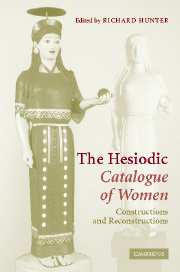Book contents
- Frontmatter
- Contents
- Notes on contributors
- Acknowledgements
- List of abbreviations
- Introduction
- 1 Ordering women in Hesiod's Catalogue
- 2 The beginning and end of the Catalogue of Women and its relation to Hesiod
- 3 Gods among men? The social and political dynamics of the Hesiodic Catalogue of Women
- 4 Heracles in the Hesiodic Catalogue of Women
- 5 Mestra at Athens: Hesiod fr. 43 and the poetics of panhellenism
- 6 A catalogue within a catalogue: Helen's suitors in the Hesiodic Catalogue of Women (frr. 196–204)
- 7 Pulp epic: the Catalogue and the Shield
- 8 The Megalai Ehoiai: a survey of the fragments
- 9 Ordered from the Catalogue: Pindar, Bacchylides, and Hesiodic genealogical poetry
- 10 The Hesiodic Catalogue and Hellenistic poetry
- 11 From genealogy to Catalogue: the Hellenistic adaptation of the Hesiodic catalogue form
- 12 The Hesiodic Catalogue of Women and Latin poetry
- 13 Or such as Ovid's Metamorphoses …
- Bibliography
- Index of passages discussed
- General index
2 - The beginning and end of the Catalogue of Women and its relation to Hesiod
Published online by Cambridge University Press: 22 September 2009
- Frontmatter
- Contents
- Notes on contributors
- Acknowledgements
- List of abbreviations
- Introduction
- 1 Ordering women in Hesiod's Catalogue
- 2 The beginning and end of the Catalogue of Women and its relation to Hesiod
- 3 Gods among men? The social and political dynamics of the Hesiodic Catalogue of Women
- 4 Heracles in the Hesiodic Catalogue of Women
- 5 Mestra at Athens: Hesiod fr. 43 and the poetics of panhellenism
- 6 A catalogue within a catalogue: Helen's suitors in the Hesiodic Catalogue of Women (frr. 196–204)
- 7 Pulp epic: the Catalogue and the Shield
- 8 The Megalai Ehoiai: a survey of the fragments
- 9 Ordered from the Catalogue: Pindar, Bacchylides, and Hesiodic genealogical poetry
- 10 The Hesiodic Catalogue and Hellenistic poetry
- 11 From genealogy to Catalogue: the Hellenistic adaptation of the Hesiodic catalogue form
- 12 The Hesiodic Catalogue of Women and Latin poetry
- 13 Or such as Ovid's Metamorphoses …
- Bibliography
- Index of passages discussed
- General index
Summary
The discovery of the extensive proem to the Catalogue in a papyrus published in 1956 revived the old question of the relation between the Ehoiai and the rest of the Hesiodic corpus. While the authenticity of the Catalogue and its attribution to Hesiod were widely accepted in antiquity, modern philologists have reached no consensus on its genuineness or its date. As so often in such controversies, supposedly ‘objective’ criteria – linguistic, stylistic, and historical evidence – have been invoked to argue both for and against Hesiodic authorship. But these criteria too have changed as our knowledge of archaic Greece has evolved and expanded. Recently, Dräger, on historical grounds, and Arrighetti, on literary ones, have argued for genuineness. Stylistic arguments are, as we all know, notoriously subjective: if the Theogony and the Works and Days were not traditionally ascribed to one author, would most scholars have done so?
Often, the rejection of Hesiodic authorship for the Catalogue derives from an unspoken premise: if Hesiod's poetry constitutes an implicit polemic against heroic epic, then we should not assign to Hesiod a composition dealing with the heroic tradition, far less one that attempts to give an exhaustive account of the heroic age from beginning to end. But such an antagonism to heroic epic is a scholarly invention, arising, as I have argued elsewhere, from a misinterpretation of the Theogony's proem.
- Type
- Chapter
- Information
- The Hesiodic Catalogue of WomenConstructions and Reconstructions, pp. 25 - 34Publisher: Cambridge University PressPrint publication year: 2005
- 37
- Cited by

